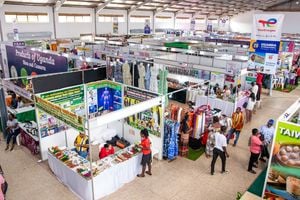
Some customers leave the UMA exhibition show Grounds in Lugogo after touring different stalls last week. PHOTO/MICHAEL KAKUMIRIZI
1. Return on investment
Slightly more than 100,000 visitors made it to the 30th Uganda Manufacturers Association (UMA) International Trade Fair held in Kampala, according to the organisers. Compared to the previous year, UMA officials say the nine-day trade fair registered what they describe as “satisfactory performance”. More than 25 countries across the continent exhibited at Uganda's high-level trade, investment and business exhibition – a calendar event in Uganda.
During the nine days that ended last week, more than 1,000 exhibitors, including businesses from the EAC region and beyond showcased their products and services to the visitors and buyers while exploring opportunities and exchanging information at the same time.
Although deals were expected to be cut, projected before the event to translate to at least slightly over $5 million (Shs18 billion) in trade and investment, it was not clear how much was secured if any by close of business last week on Wednesday. But the bottom line irrespective of everything is that it was a well-delivered trade fair for the 30th year.
2. Manufacturers still waiting for $5 cents electricity tariff
Be as it were, the manufacturers are not living in a dreamland. The cost of electricity is an issue for manufacturers who, to date, are still waiting for President Museveni’s directive to be effected of reducing the power tariff to $5 cents, down from current $11 cents per unit of electricity. There was an instance in the early days of the trade fair when power blacked out, leaving exhibitors who were setting up angry.
Manufacturers in Uganda cite high electricity tariffs as a major factor contributing to the elevated cost of doing business. Coupled with the high cost of transport and acquisition of raw materials, which affect manufacturing, the government hopes to grow the economy’s size, from its current estimate of $53.3 billion to $500 billion over the next 15 years, a tough ask.
3. Umeme fears
It is no longer a secret that Umeme’s concession expires early next year precisely in March 2025. The country’s main electricity distribution company also listed on the Uganda Securities Exchange and cross-listed on the Nairobi Securities Exchange will be handing over operations to the government come next year. Under the new name: Uganda National Electricity Company Limited (UNECL), it will be in charge of the generation, transmission and distribution of electricity upon concessionary expiration of Eskom and Umeme contracts barely six months from today. There is now fear among economic sector players with manufacturers being one of the concerned actors regarding the future of the electricity sector.
In response, the Prime Minister of Uganda, Ms Robinah Nabbanja said the government will take over operations as planned. As a result, the cost of power will reduce on account that the government is in charge of the sector. This is not only commendable but also a lesson for the government that it cannot continue to abdicate its role in the guise that “government has no active role in business” because “it is a private sector-led economy” and therefore, everything should be at the mercy of profit-motivated economic sector players.
4. Sleepwalking?
UMA board chairman Deo Kayemba, is not in the habit of mincing words. He believes that becoming an industrialised nation is not through sleepwalking but intentional. Making money and becoming rich from a venture whose foundation is shaky is like building a castle in the air.
Mr Kayemba says industrialisation should be a mindset if not a culture that should be inculcated into “our children.”
Producing engineers and electricians at university is not enough. University should churn out products whose appreciation of manufacturing, value addition and industrialisation, is properly set and ready to hit the ground running.
5. BUBU
Buy Uganda, Build Uganda (BUBU) is a government policy which was approved by the Cabinet in 2014 and launched in 2017 to promote the consumption and procurement of goods and services produced locally. At the UMA International Trade Fair concluded last week, domestically manufactured products were conspicuous on the shelves. More than 90 percent of exhibitors were either locals or from the East African region.
Exhibitors with foreign roots said they have since set up a shop here. Many expressed desires to establish presence here.
Many whom Prosper Magazine spoke to were happy to produce locally here, demonstrating the spirit of BUBU policy. If this happens, there is a chance that the quality and competitiveness of domestic products on both the local and international markets will be enhanced. This will also pave the way to job creation instead of “donating” them elsewhere. As a result, growth in industry mainly driven by value addition in manufacturing, construction and agriculture will be evident – boosting exports and import substitution for a country that is a net importer.
6. Pavilions
The Uganda Manufacturers Association (UMA) Trade Fair also created a job link programme to link job seekers, graduates and interns with relevant skills to industrialists capable of leveraging those abilities. This pavilion pulled huge numbers of young people. Then there was an education and agriculture pavilion showcasing the tools and information needed to drive forward the sectors that many people believe are archaic.
7. Exhibition or selling competition
As always, there seems to be a thin line between trade exhibitions and selling bonanza – usually at a discounted price. At times it was difficult to understand whether the exhibitors' intention was first to exhibit and explain their products or were looking for an opportunity to make a profit, thanks to the trade fair platform.
Some exhibitors concentrated fully on selling their products rather than marketing them or demonstrating how they work. In some instances, it looked like a market instead of a trade fair. Overall, however, the trade exhibition vibe was strong.
8. Room for micro and small businesses
Increasingly, the trade fair is becoming a place for Micro and Small businesses to make a statement and even thrive.
A whole hall was dedicated to them or at least a room where they could have their say. May this continue because the majority of such exhibitors/traders are Ugandan exhibitors or domestic traders.
9. Market access
Of all markets, access to the EAC one is still problematic. Blatant breach of EAC common market protocols by partner states other than Uganda is still an issue despite the regional market being a direct market for Uganda. This is not helped by the fact that only slightly more than 50 percent of Uganda’s industrial capacity is properly utilised. This calls for export guarantee schemes which seem elusive for reasons beyond manufacturers' doing.
10. Business and pleasure
Entertainment was part of the show. Loud music, lively eatery spots, busy restaurants and bars, roadside chefs serving Nyama Choma, roasted chicken and quick snacks were all easy to spot.
Children had fun. Cases of pickpockets were minimal because security was tight.
Despite the nine day trade exhibition, there were some unhappy customers. Complaints ranged from hidden stalls to the uncontrolled flow of running water.




